Pine nuts are one of my favorite wild edibles; they are surprisingly abundant and easily recognizable.
Where Do Pine Nuts Come from?
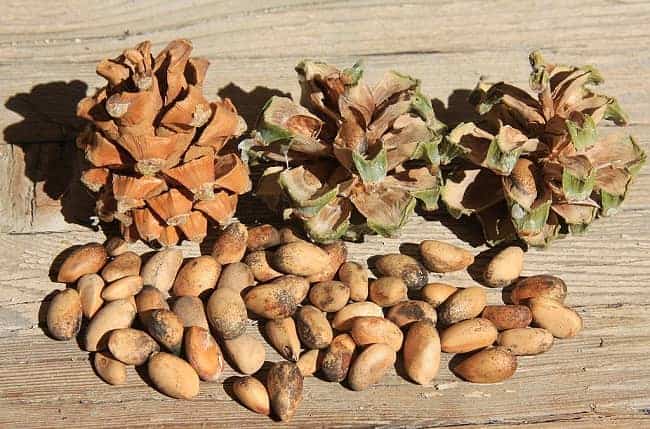
It should be obvious, but those expensive pine nuts we buy in supermarkets come from pine trees.
Considering that pine trees are all over the place, it makes you wonder why pine nuts are so expensive.
The cost mainly depends on how difficult it is to shell pine nuts. As you will discover, there is no easy way to shell them.
In a survival situation, you probably won’t mind. But, for everyday eating, you might give up and buy a pound of shelled pine nuts rather than do the work yourself.
Step 1: Finding Pine Cones for Harvesting
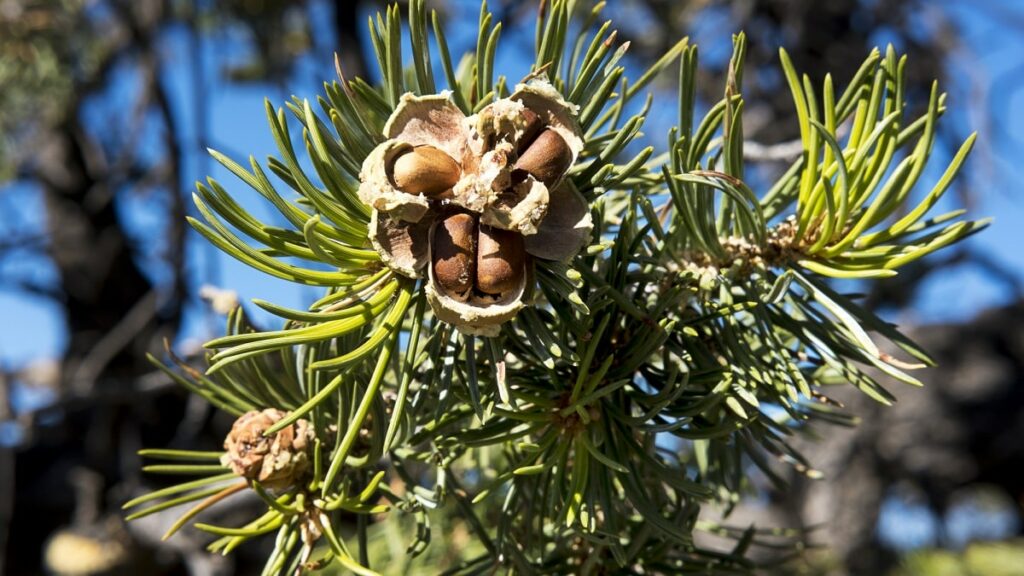
All pine trees produce nuts that you can eat. However, some species have much smaller nuts. It is worth it to scout out the species with larger nuts and save yourself some trouble with shelling.
In North America, the species of pine trees which are most commonly used for pine nuts are:
- Colorado pinyon (pinus edulis)
- Single-leaf pinyon (pinus monophylla)
- Mexican pinyon (pinus cembroides)
If you are serious about harvesting pine nuts, you should scout out some pine trees in early summer. Pine cones are usually ready for harvesting from August to September, depending on where you live.
How will you know that the pine cones are ready to be harvested?
Take a look at the tree. It is harvest time if some pine cones are open and some are still closed!
The seeds probably haven’t formed if all the pine cones are still closed.
If all pine cones have opened, then critters have probably already eaten all the seeds.
Step 2: Gather Your Pine Cones
Pine sap is sticky (read how to make pine pitch here). It is recommended that you use GLOVES when picking pine cones.
Gather the pine cones which are still closed or barely open. Twist the pine cone to get it off the tree. Try not to break any branches. You don’t want to damage the tree. Put your pine cones into a bag and bring them home.
Step 3: Getting the Pine Nuts Out of the Cones
Two things will make a closed pine cone open up: dryness and heat.
The easiest way to get the pine nuts out of the cone is to lay the pine cones out and let them dry out on their own. It will take a few weeks, but the pine cones will open up. Then, you can tap the pine cones, and the seeds will fall out.
You can use heat if you don’t feel like waiting 3 weeks for your pine cones to open up.
Lay the pine cones flat and roast them in the oven (or over a fire). Let the pine cones cool down. Then tap them, and the pine nuts will start to fall out.
Don’t try to microwave pine cones. They’ll start to smoke and ruin your microwave!
Alternative Collection Method: If it is already late in the season and the pine cones have opened up, you can use this method to gather the pine nuts.
Put a big tarp under the pine tree. Then shake the branches of the pine tree hard.
This will make the remaining pine nuts (the ones which haven’t been eaten by critters yet) fall out of the cones and land on your tarp.
Step 4: Sorting
Even if you harvest your pine nuts on time, there will still be a lot of bad pine nuts. It is frustrating to shell the nuts only to find out it is not good.
Here is a simple way to separate the bad pine nuts from the good ones.
- Put your pine nuts in a big bowl of water.
- The bad pine nuts will float to the top.
- The good pine nuts will sink to the bottom!
- Most of the floaters are going to be bad.
- Some will still be good, but I’d rather toss some good pine nuts than waste a lot of time shelling bad pine nuts.
If you don’t want to toss the bad pine nuts, you can use them to make pine nut vodka. In Russian, it is called kedrovka.
Pine Nut Vodka Recipe:
- Fill a bottle about 1/3 full of pine nuts in the shell.
- Fill the rest of the bottle with vodka.
- Close the bottle and let it sit in a dark area for at least 3 weeks. The essential oils from the pine nuts will leach into the vodka.
- Drink and enjoy! There is no need to filter or do anything else!
Step 5: Shelling
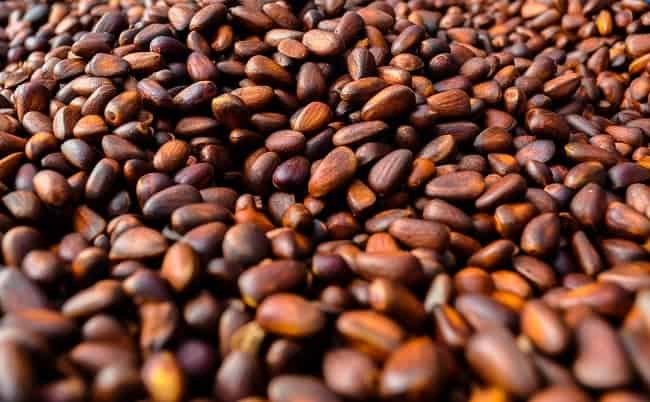
Shelling pine nuts is a big hassle, and there isn’t a fast way to do it at home.
Most people shell pine nuts with their teeth, much like how you’d eat a sunflower seed in the shell. That makes them great for snacking.
Or, you can use your fingers to crack the pine nut shell. Here is a good video showing how to shell a pine nut.
I wouldn’t recommend smashing the pine nut shell because you’ll probably smash the small nut inside too.
Related
Pine trees are a fantastic resource, and most parts of the tree are edible.
See these articles for more:
Dcrjsr [CC BY 3.0], via Wikimedia Commons
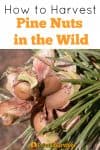
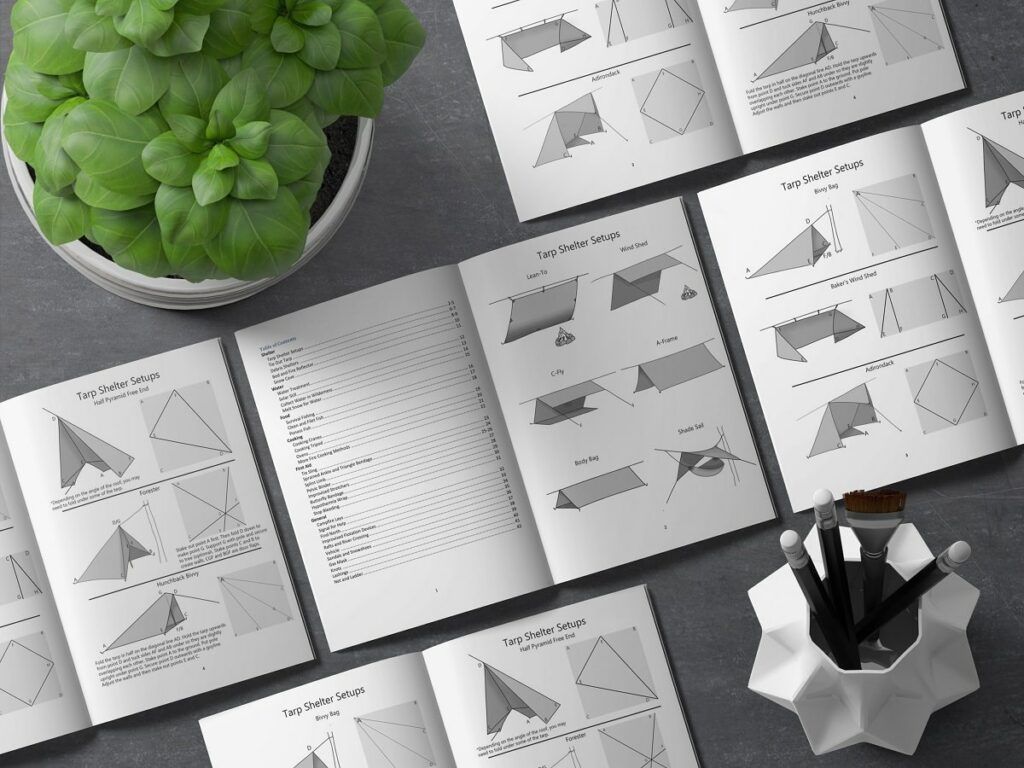

Typographic error:
Colordao pinyon (pinus edulis)
Should read
Colorado . . . .
Updated. Thanks!
What if you took a rolling pin and lightly rolled the nuts to cracking the shells?
What pines with decent sized nuts can I find in southwest Ohio?
I’d suggest getting a local plant ID book. There are some great national identification books but local ones make it a lot easier.
When I was a young kid and my dad was in the military, we lived in Madrid, Spain. We would go up to the mountains on the weekends in the winter. There were always vendors selling roasted pine nuts. They would come in a paper cone made from newspaper and with each cone they gave you a nail that had the point flattened. The roasted nuts were cracked from the heat from the roasting process. You would use the flattened nail to pry the nuts open. It worked well and the nuts were delicious.
I dont know how they roasted them but a google search search found that roasting them in a single layer on a cookie sheet at 350° for 7 to 10 minutes or until they start to pop should do the trick.
use snake tongs to shake branches like an artificial hand and they are cheap and have my uses even such as to pull down dead firewood branches others cant reach. also when hiking through bushes and such you can reach forward and pull branches and sticker bushes out of the way. when you have a good spot early and take a rake and rake out all the stuff from under the tree from last season. then return instead of nuts all over the place is deep brush and pineneedles and old pine cones. the fresh ones you pick up you can also take them over to a screen with an old sheet under and shake and crush up the cones with gloves or many methods.
I just looked up snake tongs. Those look awesome and incredibly useful for harvesting food from trees (especially for really short people like me). Thanks for the tips.
I live in Texas where the pines are so tall and big that there is no way really to shake a tree well or climb that far up. If I wait until they fall, is it probably too late?
Unfortunately, it is probably too late if they’ve already fallen. I often pick up pine combs from the ground and have yet to find one with nuts still inside. The squirrels and insects are just too quick 🙂
I’ve been thinking about your question and I think I may have a solution for you. First suspend a tarp around the tree you want to harvest from then higher up on the tree suspend small bird netting over the tarp to keep critters out and hopefully as the cones open hopefully the pine nuts will fall through the net and be caught by your tarp.
Does it matter what type of pine tree it is I live in michigan
All pine trees produce edible nuts. Just some types might be really tiny and insanely annoying/difficult to harvest. I’d suggest you start scouting out some pine trees now and head back there in late summer to harvest them.
We make it a family weekend to go pick pinon through out pinon season here in northern New Mexico. We camp out in the forest and have a great time.
When I was growing up (80’s) in New Mexico going camping meant we would be gathering piñon. Great memories and of course the big pay off!! PIÑON. I can almost smell the nuts roasting now. So delicious!!
One more thing – if you get the sap on your hands use cooking oil to clean it off, then wash that off with dish soap. If you get it on your clothes (I recommend you wear something old) use rubbing alcohol.
Thanks for the trick about the floating nuts being the duds! It seems to me like the darker the color, the better the nut inside, so I’ve been just picking those. I started several weeks ago with picking the whole cones but picking this weekend when most of the cones were already open but still have plenty of seeds in them was much more efficient. I could just grab a branch and with my other hand gently pry apart the cone to let the seeds fall into my hand or a bucket. I can do the reachable parts of a good sized pinon tree in about an hour and ended up with a quart sized ziploc of seeds. The best way I’ve found to crack the shells is with a hammer, very gently just a couple taps to crack it enough to pry it off with your fingers. Set the nuts on a paper towel so they don’t slide around when you’re tapping them.
Thanks for the tips Lori, sounds like you have a good system working there.
Hello, can pine cones be dehydrated to gain access to the nuts/seeds?
I assume this would work – try it and let us know.
In Nevada if the pine cones are green on Sept. 5 do they still have another season to go before they are ripe?
I have 4 parrots that just love pine nuts and I am going to try to harvest some pine nut There is a large pine tree in the yard next door which leans over our fence. I always considered it a messy tree, because of all the pine cones it drops in our yard and I have to pick up. Now I will look at the pine cones differently.
You are so lucky I am in Edinburgh Scotland
no pine trees in the city and pine nuts are very expensive to buy.
Going to try harvesting some in august. Plenty of pine trees around in Western Washington.
Yes I have two trees of pine nut in my house,but before this post I never any idea how to harvest and now will try to get alot of pine nut thank u very much about your knowledge to share with people.
Awesome – let us know how it goes.
If you have a fire pit throw them next to the fire until they are smoking hot! That is how the Native Americans do it.